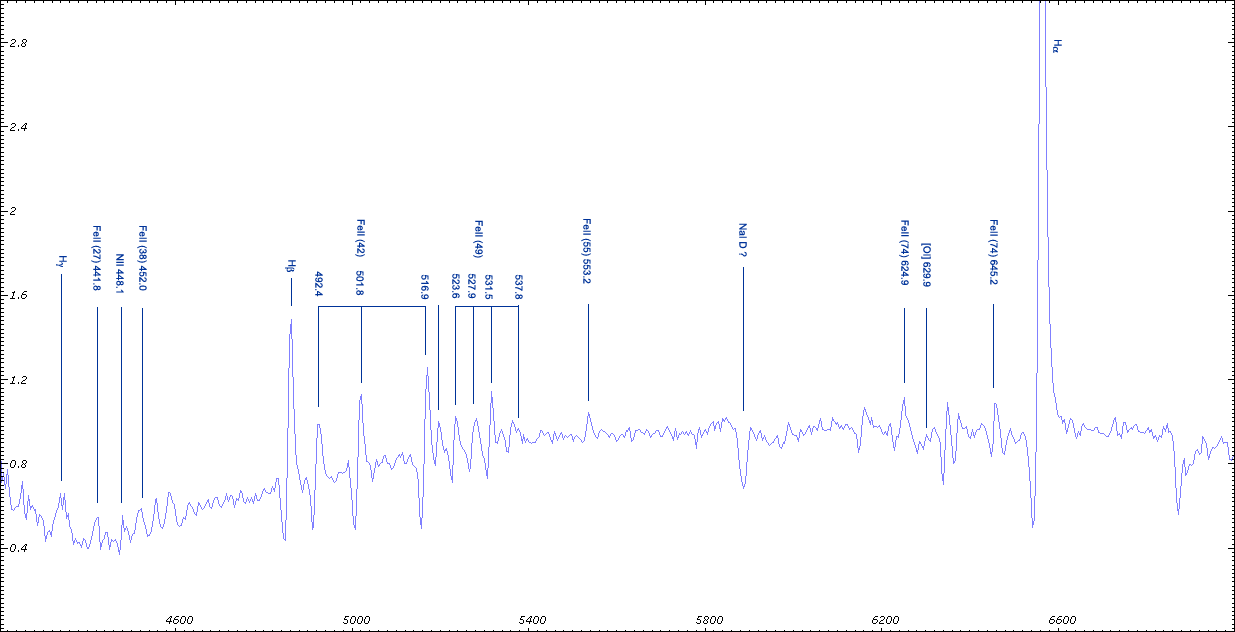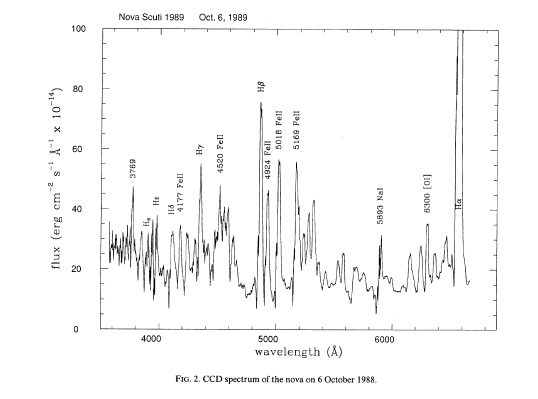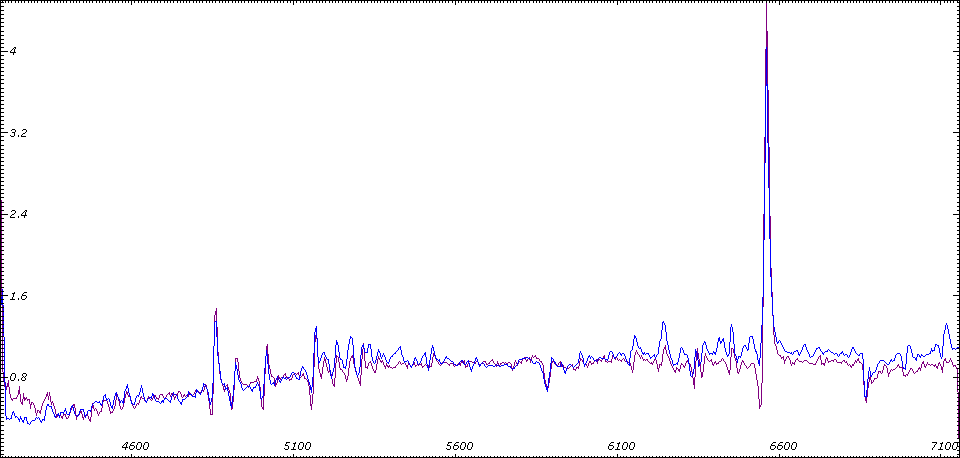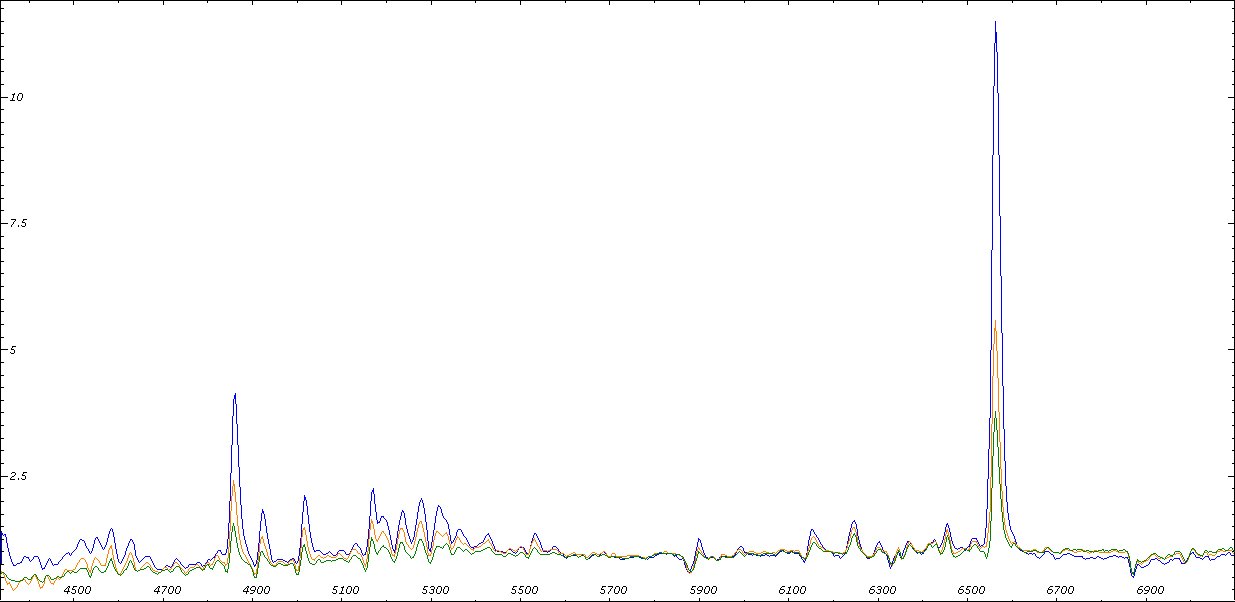
Projets Spectroscopie 4
Novae
Nova Scuti 2009
Télécharger :
Animation Novembre Décembre 2009 PDF (cliquez sur l'image pour passer à la suivante)
Animation Novembre Décembre 2009 OpenOffice
Animation Novembre Décembre 2009 Power Point
Rem :
Continuum normalisé à 1
Magnitudes estimées à partir des observations AAVSO et VSNET
Nova Scuti 9 novembre 2009
AAVSO Special Notice #176
Possible Nova in Scutum November 9, 2009
CBET #2008 (D.W.E. Green, editor) announced the discovery of a possible
nova in Scutum on November 8, 2009.
The new object was discovered by Hideo Nishimura
(Miyawaki, Kakegawa, Japan) on 2009 Nov 8.37 UT (JD 2455143.87)
who found the object near magnitude 8 on an image taken with a 120-mm camera lens and DSLR.
The new object has since been confirmed by E. Guido and G. Sostero
using a Global Rent-a-Scope telescope near Mayhill, New Mexico, USA
on 2009 Nov 09.08 UT (JD 2455144.58). Guido and Sostero report an unfiltered magnitude of 8.5,
and provide the following astrometry of the new object:
RA: 18:43:45.57 , Dec: -07:36:42.0 (J2000)
LX200 10" Lhires III Starlight SXV H9
Dispersion 4,28 A/px
Divisé par la réponse instrumentale obtenue sur Altaïr
Continuum normalisé à 1 sur la zone 6000-6100 A
Identification des raies (spectre du 10 11 2009) à partir de :
- Circulaire IAU 9093
- Spectra and Light Curve Analysis of Nova V475 Scuti
G.E. Morgan, F.A. Ringwald, C. Buil, and M. Garrett
PASP, 117:938-943, 2005
- V463 Scuti (Nova Sct 2000) Rapid evolving nova with a prominent premaximum halt
T. Kato & a., PASJ, 2008
Identification des raies (spectre du 06 12 2009, 17 jours après le maximum) à partir des études de V443 Sct 1989 ([1] & [2])
- Raies d'émission HI, Fe, NII, OI, Na
- Raies interdites [OI] (à 557.7, 630,0 et 636,4 nm)
Spectre V443 Sct 1989 (L. Rosino & al., A.J. vol. 101, 5 (1991) ) pour comparaison
Mesure de la vitesse d'expension
Principe : le profil "P Cygni" apparaissant sur certaines raies pemet de déterminer le décalage en longeur d'onde entre la composante d'absortion et la raie en émission.
Calcul et Méthode de mesure :
Avec c = 300 000 km/s, V est obtenue en km/s
La détermination précise de la longueur d'onde est délicate à cette faible dispersion. Elle est également du profil des raie.
Le spectre a été rééchantillonné à 1A/px.Méthode 1 : détermination visuelle du maximum
Méthode 2 : le maximum est encadré dans une zone restreinte et la valeur de la raie est déterminée par la mesure automatique de Visual SpecMéthode
a
Spectre du 10 11 2009
1 a b
2 a b
3 a b
4 a b
5 a b
Ha Moyenne des mesures sur les raies 1 à 5
Méthode a : V = 763 km/s
Méthode b : V = 784 km/sOn retiendra V = 800 km/s
Incertitude sur la mesure estimée à partir de la dispersion des mesures (2 sigma) : 120 km/s
Ce qui donne : V = 800 (+/- 120) km/s
(Les deux séries de mesure de la circulaire IAU#9093 donnent 700 km/s)
Evolution du spectre
Comparaison spectres 10/11/2009 [Violet] et 17/11/2009 [Bleu]
On note : affaiblissement du profil P Cygni
Evolution : 18/11 (vert) - 19/11 (orange) - 22/11 (bleu)
Echelle longueur d'onde : 4500-7000
Echelle intensités : 0-12
Normalisé à 1 sur 6000-6100
Evolution du spectre 29/11/2009 - 09/09/2010
Bibliographie
Publications
D. Balam, Dominion Astrophysical Observatory, National Research Council of Canada (NRCC); and G. Sarty, University of Saskatchewan, write that a spectrogram (range 429-455 nm, resolution 0.02 nm), obtained with the NRCC 1.82-m Plaskett telescope on Nov. 10.08 UT, confirms that this object is a nova, showing H_alpha emission (HWZI about 400 km/s) with a P-Cyg profile, its absorption minimum being blue-shifted by 700 km/s with respect to the emission peak. Additional lines showing P-Cyg profiles include N II (448.1 nm), Fe II (multiplet 27) at 435.0 and 441.8 nm, and Fe II (multiplet 38) at 452.1 nm. U. Munari and A. Siviero, Istituto Nazionale di Astrofisica, Padova Astronomical Observatory; and L. Buzzi and P. Valisa, Asiago Novae and Symbiotic Stars (ANS) collaboration , report that low- resolution, absolute spectrophotometry (range 390-860 nm, dispersion 0.21 nm/pixel) of the nova were obtained on Nov. 9.779 UT with the 0.6-m telescope of the Schiaparelli Observatory in Varese. The spectrum is dominated by emission lines due to Balmer, Fe II (multiplets 27, 28, 37, 38, 42, 48, 49, 55, and 74), and O I 777.2- and 844.6-nm, all displaying deep P-Cyg profiles, with the absorption component blue-shifted by 700 km/s from the emission component. The mean FWHM of the emission and absorption of the P-Cyg profiles are 950 and 850 km/s, respectively. The H_alpha: H_beta:H_gamma:H_delta integrated emission-flux ratio is 3.68:1.00: 0.23:0.16, and that of O I (777.2 nm)/(844.6 nm) is 0.91. The overall aspect is that of a typical nova of the Fe II class, observed close to maximum brightness. (C) Copyright 2009 CBAT 2009 November 10 (9093)Daniel W. E. Green[1] Spectral evolution of nova V 443 Scuti 1989
G.C. Anupama & al.
Astron. Astropys., 263, 87-96 (1992)
[2] Spectroscopic observation of nova V443 Scuti 1989
L. Rosino & al.
A.J. vol. 101, 5 (1991)Spectra and Light Curve Analysis of Nova V475 Scuti
G.E. Morgan, F.A. Ringwald, C. Buil, and M. Garrett
PASP, 117:938-943, 2005
V463 Scuti (Nova Sct 2000) Rapid evolving nova with a prominent premaximum halt
T. Kato & al., PASP, 117:938-943, 2005The formation of novae spectra
R.E. Williams
A.J., Vol. 104, Number 2, 199The evolution and classification of postoutburst novae spectra
R.E. Williams & al.
A.J., 376:721-737, 1991


























